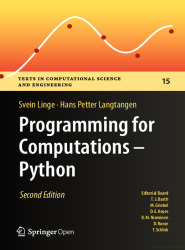Programming for Computations - Python
The book was inspired by the Springer book TCSE 6: A Primer on Scientific Programming with Python (by Langtangen), but the style employed is more accessible and concise, in keeping with the needs of engineering students.
The book outlines the shortest possible path from no previous experience with programming to a set of skills that allows students to write simple programs for solving common mathematical problems with numerical methods in the context of engineering and science courses. The emphasis is on generic algorithms, clean program design, the use of functions, and automatic tests for verification.
Table of contents
- The First Few Steps
- 1.1 What Is a Program? And What Is Programming?
- 1.2 A Python Program with Variables
- 1.3 A Python Program with a Library Function
- 1.4 Importing from Modules and Packages
- 1.5 A Python Program with Vectorization and Plotting
- 1.6 Plotting, Printing and Input Data
- 1.7 Error Messages and Warnings
- 1.8 Concluding Remarks
- 1.9 Exercises
- A Few More Steps
- 2.1 Using Python Interactively
- 2.2 Variables, Objects and Expressions
- 2.3 Numerical Python Arrays
- 2.4 Random Numbers
- 2.5 Exercises
- Loops and Branching
- 3.1 The for Loop
- 3.2 The while Loop
- 3.3 Branching (if, elif and else)
- 3.4 Exercises
- Functions and the Writing of Code
- 4.1 Functions: How to Write Them?
- 4.2 Programming as a Step-Wise Strategy
- 4.3 Exercises
- Some More Python Essentials
- 5.1 Lists and Tuples: Alternatives to Arrays
- 5.2 Exception Handling
- 5.3 Symbolic Computations
- 5.4 Making Our Own Module
- 5.5 Files: Read and Write
- 5.6 Measuring Execution Time
- 5.7 Exercises
- Computing Integrals and Testing Code
- 6.1 Basic Ideas of Numerical Integration
- 6.2 The Composite Trapezoidal Rule
- 6.3 The Composite Midpoint Method
- 6.4 Vectorizing the Functions
- 6.5 Rate of Convergence
- 6.6 Testing Code
- 6.7 Double and Triple Integrals
- 6.8 Exercises
- Solving Nonlinear Algebraic Equations
- 7.1 Brute Force Methods
- 7.2 Newton's Method
- 7.3 The Secant Method
- 7.4 The Bisection Method
- 7.5 Rate of Convergence
- 7.6 Solving Multiple Nonlinear Algebraic Equations
- 7.7 Exercises
- Solving Ordinary Differential Equations
- 8.1 Filling a Water Tank: Two Cases
- 8.2 Population Growth: A First Order ODE
- 8.3 Spreading of Disease: A System of First Order ODEs
- 8.4 Oscillating 1D Systems: A Second Order ODE
- 8.5 Rate of Convergence
- 8.6 Exercises
- Solving Partial Differential Equations
- 9.1 Example: Temperature Development in a Rod
- 9.2 Finite Difference Methods
- 9.3 Exercises
| Pages : | 350 |
| Size : | 7.3 MB |
| File type : | |
| Downloads: | 136 |
| Created: | 2022-02-03 |
| License: | CC BY |
| Author(s): | Svein Linge, Hans Petter Langtangen |

Warning: Trying to access array offset on false in /home/tutovnfz/public_html/article.php on line 233
Others programming Tutorials
Principles of Programming Languages
Practical Foundations for Programming Languages
Programming for Computations - Python
Fundamentals of C++ Programming
Programming Persistent Memory: A Comprehensive Guide for Developers
Others related eBooks about Programming for Computations - Python
Getting started with SharepointDownload free Sharepoint tutorial course in PDF, training file in 10 chapters and 75 pages. Free unaffiliated ebook created from Stack OverFlow contributor....
First Semester in Numerical Analysis with PythonDownload free course First Semester in Numerical Analysis with Python, pdf file on 191 pages by Yaning Liu....
Perl tutorial for professionalsDownload free Perl tutorial course in PDF, training file in 39 chapters and 109 pages. Free unaffiliated ebook created from Stack OverFlow contributor....
Coding for kidsThis PDF book teaches you how to encourage your kids to code at home, a guide to empowering kids with coding skills....
PC Assembly LanguageThis book has extensive coverage of interfacing assembly and C code and so might be of int..., download free Assembly tutorial in PDF (190 pages) created by Paul Carter ....
C++ Hacker's GuideDownload free course C++ Hacker's Guide, pdf file on 231 pages by Steve Oualine....
Programming in LuaThis book is for students and professionals who are intrigued by the prospect of learning and using a powerful language that provides a rich infrastructure for creating programs. No programming knowledge is necessary to benefit from this book except for the section on Lua bindings, which requires so...
Test-Driven Development with PythonDownload free course Test-Driven Development with Python, pdf file on 502 pages by Harry J. W. Percival....
Bash programming ebook for professionalsDownload free bash tutorial course in PDF, training file in 67 chapters and 204 pages. Free unaffiliated ebook created from Stack OverFlow contributor....
You Don't Know JS Yet: Scope and ClosuresDownload free course You Don't Know JS Yet: Scope and Closures, pdf file on 279 pages by Kyle Simpson....